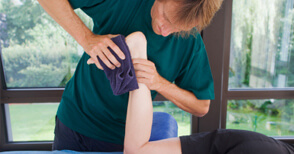What is Achilles Tendonitis?
 As the name implies, this is an inflammatory condition of the Achilles tendon – the largest tendon in the body, which connects the calf muscles to the heel bone. Although it’s designed to withstand the large forces that occur during walking and running it is nonetheless susceptible to injury, especially in sporty individuals who exercise frequently.
As the name implies, this is an inflammatory condition of the Achilles tendon – the largest tendon in the body, which connects the calf muscles to the heel bone. Although it’s designed to withstand the large forces that occur during walking and running it is nonetheless susceptible to injury, especially in sporty individuals who exercise frequently.
Causes of Achilles Tendonitis
Achilles tendonitis is an overuse injury, occurring when forces on the tendon become too large and/or too repetitive. This can result in micro tears to the Achilles tendon and consequent inflammation.
The condition is frequently seen in running and jumping sports and tends to be one of the most common injuries among athletes. It’s not limited to athletes, though – it can also be caused by poorly fitting footwear, or flat feet, tight calf muscles, or even rheumatoid arthritis.
Treatment for Achilles Tendonitis
Treatment for Achilles Tendonitis varies, though a good start is to ensure proper warm up and stretching exercises before taking part in activities that stress the foot aggressively, such as hill running and sprinting. Rest, accompanied by the application of an ice bag, wrapped in a thin towel, over the tendon can be helpful, as can manual therapy to loosen the calf muscles. Other approaches include:
- Prescription orthotics for those who over pronate (typically those who have flat feet).
- A combination of stretching and strengthening exercises.
- Anti inflammatory drugs.
- In persistent cases, surgery may need to be considered.
How to Prevent Achilles Tendonitis
If you’re an active type, make sure that warm ups and stretching exercises for the Achilles and calves are part of your routine. Ideally, you should stretch after as well as before exercise. Always wear shoes that have an arch, as running in a shoe without arches puts the Achilles tendon under greater pressure.
If you train or compete at regularly, or at a high level, you should consider having massage therapy from time to time to ensure that the calf muscles are not too tight, so that the Achilles is not under too much stress. This will reduce the risk of injury.
